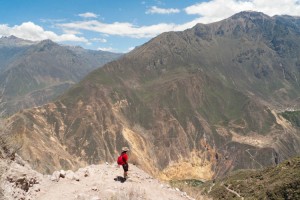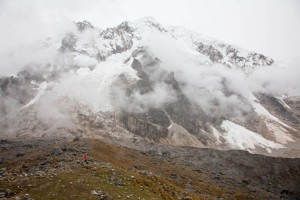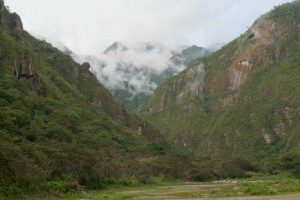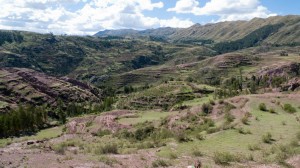Colca cayon, about 150km north from Arequipa, is a large canyon which at 4,160 m deep is more than twice as deep as the Grand Canyon in the United States. Until a few years ago, this was believed to be the deepest canyon in the world: Now that title goes to the Cañon de Cotahuasi, just 100km to the west, which is deeper by some 150m or so. Still, Cañon del Colca was incredibly impressive in it’s own right; From tiny traditional villages, soaring condors overhead, and huge snow-capped mountains looming in the distance, to the backpacker-mecca of ‘The Oasis’ with its palm-shaded swimming pools in the bottom of the canyon- This was a great mix of rugged nature, culture, and relaxation.
Tag Archive > Hiking
Salkantay
Lena and I decided to attempt the Salkantay Trail, a 56 km trail beginning in the small town of Mollepata, passing through a 4,800 meter pass next to Apu Salkantay, and finally ending in Aguas Calientes, at the base of Machu Picchu. We made the trek in five days, with no guide, and have put together this report to document our journey. There is a lot of information (and photos!) here, and I have tried to include as much information as possible for someone who wishes to attempt this trek on their own, as well as portray our personal journey on this trail. This post is divided into sections, beginning with an introduction to the trail, followed by a day-by-day summary of our adventures.
The famous Salkantay Trek, named among the 25 best Treks in the World, by National Geographic Adventure Travel Magazine, is a trek open to everybody, with no limitation on spaces or permits (at least for now). Connecting the city of Mollepata with Machu Picchu, the Salkantay Trek is an ancient and remote footpath located in the same region as the Inca Trail where massive snowcapped mountains collide with lush tropical rain forests.
Located less than fifty miles northwest of the city of Cusco in south central Peru by the Cordillera Vilcabamba and rising to 6271 meters above sea level (20574 ft) Mt. Salkantay is an outstanding glacier-capped summit worshipped for thousands of years by local indians. The name Salkantay is a quechua word meaning “Savage Mountain” (From www.salkantay.org)
Jump to:
Salkantay Introduction
Day 1 – Cusco to Mollepata
Day 2 – Mollepata to Soraypampa
Day 3 – Soraypampa, Abra Salkantay, Huaracmachay, Chaullay
Day 4 – Chaullay, La Playa, Lucmabamba
Day 5 – Lucmabamba, Llactapata, Hydro Electrica, Aguas Calientes
Salkantay – Introduction
Salcantay (Nevado Salcantay) or Salkantay (Nevado Salkantay), Sallqantay in Quechua is the highest peak of the Cordillera Vilcabamba, part of the Peruvian Andes. It is located in the Cusco Region, about 60 km (40 mi) west-northwest of the city of Cusco. It is the 38th highest peak in the Andes, and the twelfth highest in Peru. However, as a range highpoint in deeply incised terrain, it is the second most topographically prominent peak in the country, after Huascarán. (Wikipedia)
This is truly a spectacular trek, and I hope that by providing this information, it may encourage more people to attempt it this trek on their own. There is a lot of vague and misleading information on the web, and we found it very hard to find decent information beforehand when planning our trip. One of the best resources by far that I came across while planning was Vova & Olga’s very accurate and detailed Salkantay Trek Report. This was integral in making our Salkantay trip a success, and we owe them a lot of gratitude for the information!
Jump to:
Day 1 – Cusco to Mollepata
Day 2 – Mollepata to Soraypampa
Day 3 – Soraypampa, Abra Salkantay, Huaracmachay, Chaullay
Day 4 – Chaullay, La Playa, Lucmabamba
Day 5 – Lucmabamba, Llactapata, Hydro Electrica, Aguas Calientes
Salkantay – Part 5
This is the fifth and final part in a five-part series documenting our journey trekking the Salktantay Trek, from Mollepata to Aguas Calientes and eventually reaching Machu Picchu…
Day 5: Lucmabamba – Aguas Calientes
Start: 07:15 – Lucmabamba (2,250m)
POI: 10:30 – Pass (2,800m)
POI: 11:00 – Llactapata (2,500m)
POI: 14:45 – Hidro Electrica (2,050m)
End: 19:00 – Aguas Calientes (2,250m)
Summary: About a three hour, steep uphill trail along a beautiful Inca footpath to reach another pass at 2,900 meters, before descending slightly to the Inca ruins of Llactapata. From Llactapata, it was an even steeper descent to the river before reaching Hidro Electrica. From there it was a relatively easy (flat) and beautiful walk along the train tracks to reach Aguas Calientes, our final destination of the trek.
Salkantay – Part 4
This is the fourth part in a five-part series documenting our journey trekking the Salktantay Trek, from Mollepata to Aguas Calientes and eventually reaching Machu Picchu…
Day 4: Chaullay – Lucmabamba
Start: 08:30 – Chaullay (2,950m)
POI: 09:00 – Collapampa (2,850m)
POI: 13:00 – Lluscamayu (2,600m)
POI: 15:00 – La Playa (2,100m)
End: 16:30 – Lucmabamba (2,250m)
Summary: Crossed the river after Chaullay and a short half-hour uphill to Collapampa. From here, the trail turned into a drivable road, and we were offered a ride to La Playa. We chose to continue the trail, and crossed the river again to the left bank, and followed the trail. The trail here was very rocky and at times steep, with more or less equal ascending and descending sections, though throughout the day we lost about another 700 meters of altitude. The vegetation and landscape continues to become increasingly tropical, and the day is hot and humid.
Salkantay – Part 3
This is the third part in a five-part series documenting our journey trekking the Salktantay Trek, from Mollepata to Aguas Calientes and eventually reaching Machu Picchu…
Day 3: Soraypampa – Chaullay
Start: 08:30 – Soraypampa (3,850m)
POI: 09:30 – Salkantaypampa (4,100m)
POI: 11:00 – Albra Salkanta (4,750m)
POI: 14:00 – Huaracmachay (3,900m)
POI: 16:45 – Rayan-Nyoc (3,450m)
POI: 17:15 – Andenes (3,350m)
End: 18:30 – Chaullay (2,950m)
Summary: Cold morning. Starting with a moderate ascent to Salkantaypampa, before ascending steeply with many switchbacks to Albra Salkantay. From the pass, a sharp, rocky decent to Huaracmachay. Terrain and flora begin to change rapidly as the trail descends further. Much milder temperatures towards the end of the day, reaching lower altitudes.
Salkantay – Part 2
This is the second part in a five-part series documenting our journey trekking the Salktantay Trek, from Mollepata to Aguas Calientes and eventually reaching Machu Picchu…
Day 2: Mollepata – Soraypamapa
Start: 09:00 – Mollepata (2,850m)
POI: 11:30 – Cruzpata (3,050m)
End: 13:30 – Soray Pampa (3,850m)
Summary: Relatively easy ascent along a grated gravel road. 1,000 meter elevation gain from Mollepata to Soraypampa. Temperatures very hot in the morning as we began from Mollepata, but dropping quickly as we ascended to Soray. Night temperatures were very cold.
Salkantay – Part 1
This is the fist part in a five-part series documenting our journey trekking the Salktantay Trek, from Mollepata to Aguas Calientes and eventually reaching Machu Picchu…
Day 1: Cusco – Mollepata
Start: 12:00 – Cusco (3,360m)
End: 16:00 – Mollepata (2,850m)
Summary: Start from Cusco, three-hour bus ride to Mollepata where we will begin the trek. One-hour hike just outside of Mollepata to begin.
Tipon
Our very last weekend in Cusco! We had finished our Spanish classes and have been busy preparing for our upcoming journey to Machu Picchu via Salkantay. But our Spanish teacher had organized an excursion to nearby Tipon and convinced us to come along.
Tipon is an ancient Inca site in the Sacred Valley located about 15km from Cusco. It is believed to have been a hold place for upper class members of the society and a center of agricultural importance. There is also a very impressive Intiwarwi (Sun Temple) high above the agricultural terraces. This was one of the most advanced of the Incan cities in the area in terms of engineering, and there is an impressive system of canals and fountains that still function to this day- many hundred of years later.












 | Powered by
| Powered by